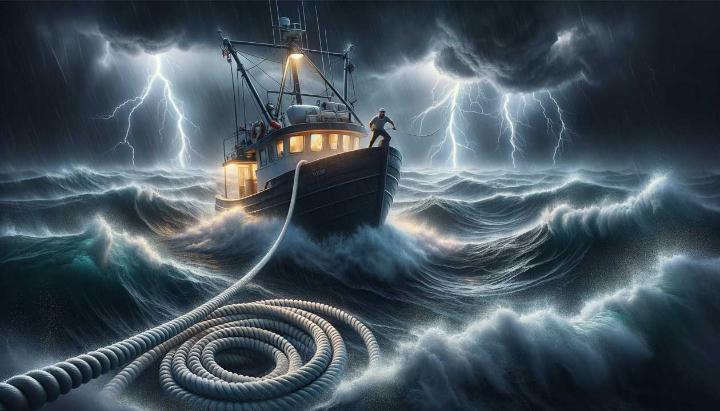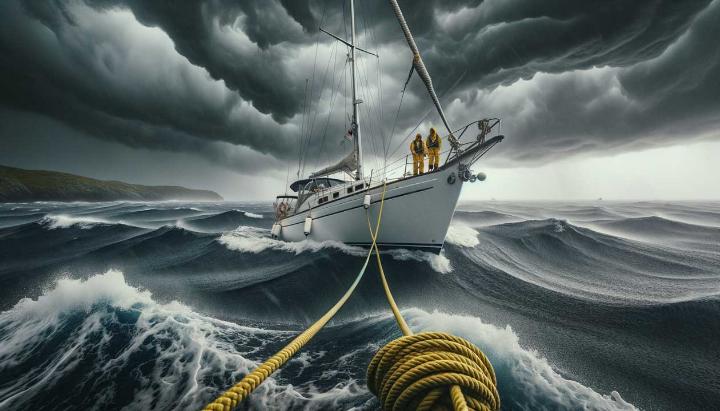Have you ever found yourself in choppy waters, relying solely on your anchor to keep you safe? The choice of anchor rope can mean the difference between a peaceful night's rest and a nail-biting ordeal. Enter the unsung hero of maritime safety: the double braid nylon anchor rope.
For years, both 3-strand and double braid nylon ropes have been the go-to choices for savvy sailors. Why? It's simple: their impressive stretch capacity and remarkable strength. But what sets double braid nylon apart, making it the superior choice for discerning boaters?
In this post, we'll dive deep into the world of nylon anchor ropes, exploring why double braid construction is revolutionising anchoring systems. From its unparalleled strength-to-weight ratio to its exceptional shock absorption capabilities, we'll uncover the features that make double braid nylon anchor rope the preferred choice for vessels of all sizes.
Whether you're a weekend warrior or a seasoned mariner, understanding the advantages of double braid nylon anchor rope could be the key to elevating your boating experience. So, grab a cuppa and join us as we unravel the secrets behind this maritime marvel. Trust us, by the end of this read, you'll never look at your anchor line the same way again.
Understanding Double Braid Nylon Anchor Rope
When it comes to anchoring your boat securely, the choice of rope can make all the difference. As an avid sailor, I've learned that double braid nylon anchor rope stands head and shoulders above the rest. Let's dive into what makes this type of rope so special and why it's become the go-to choice for savvy boaters worldwide.
Construction and Materials of Double Braid Anchor Rope
Double braid nylon anchor rope, as the name suggests, features a unique construction that sets it apart from traditional 3-strand ropes. Imagine two braided sleeves, one nestled inside the other, working in perfect harmony. This ingenious design offers a combination of strength and flexibility that's hard to beat.

The outer braid provides excellent abrasion resistance, while the inner braid contributes to the rope's overall strength. This construction allows the load to be distributed evenly throughout the rope, reducing weak points and increasing durability.
Advantages of Nylon for Anchor Ropes
Nylon isn't just any material - it's the superhero of marine ropes. Here's why it's the perfect choice for anchor ropes:
- Exceptional strength-to-weight ratio: Nylon packs a punch without weighing you down, making it easy to handle on board.
- Impressive elasticity: This allows the rope to absorb shock loads, reducing stress on your boat and anchor.
- Excellent UV resistance: Nylon stands up to the sun's harsh rays, maintaining its integrity over time.
- Water-resistant properties: Unlike some materials, nylon doesn't weaken when wet - a crucial feature for marine use.
I remember a stormy night off the coast of Sydney when our nylon anchor rope truly proved its worth. The elasticity absorbed the shock of the waves, preventing sudden jerks that could have damaged our boat or dislodged the anchor. It was a tense night, but our trusty nylon rope held firm.
Comparing Double Braid to Other Rope Types
While 3-strand ropes have their place, double braid nylon offers several advantages:
- Higher strength
- Better handling
- Less stretching
For instance, a 1/2 inch double braided nylon rope boasts a breaking strength of around 8,500 lbs - significantly higher than its 3-strand counterpart. This means you can use a thinner rope for the same load, saving space and weight on your vessel.
Have you ever considered the impact your anchor rope choice has on your boating experience? With double braid nylon, you're not just buying a rope - you're investing in peace of mind and superior performance on the water.
Nylon Anchor Rope: Superior in Shock Absorption and Stretch
As a seasoned sailor, I've experienced firsthand the crucial role that anchor ropes play in keeping vessels safe and secure. When it comes to superior performance, nylon anchor ropes stand out from the crowd, particularly in their unmatched shock absorption and stretch capabilities.
Understanding the Properties of Nylon Anchor Ropes
Nylon's unique properties make it an ideal material for anchor ropes. Its elasticity is truly remarkable, allowing it to stretch up to 20% at 50% of its break load. This might sound like a lot, but trust me, it's precisely what you want when you're anchored in choppy waters.
I remember a particularly stormy night off the coast of Queensland. The waves were relentless, but our nylon anchor rope acted like a giant shock absorber, stretching and contracting with each surge. This elasticity prevented sudden jerks that could have potentially damaged our boat or dislodged the anchor.

But why is this stretch so important? Well, it's all about energy absorption. When your boat pulls on the anchor due to wind or waves, the nylon rope stretches, absorbing the energy of the pull. This controlled stretch reduces strain on both the anchor and the boat, preventing sudden jolts and enhancing overall anchoring performance.
Comparing Nylon vs Polyester Anchor Ropes
While polyester ropes have their place in boating, they simply can't match nylon when it comes to anchor ropes. Let's break down the key differences:
- Stretch capacity: Nylon elongates by approximately 23% at rated working load, compared to polyester's mere 7%.
- Shock absorption: Nylon's superior elasticity provides significantly better shock absorption than polyester.
- Strength retention when wet: Nylon retains about 85-90% of its dry strength when wet, which is crucial for anchor ropes.
In calm conditions, you might not notice much difference. But when the weather turns foul, you'll be thankful for every bit of stretch and shock absorption your nylon rope provides.
Pro tip: While 3-strand nylon is often preferred for anchor lines due to its higher stretch, double braid nylon offers a great balance of decreased stretch with increased shock absorption, making it an excellent choice for larger vessels.
Have you ever considered how your choice of anchor rope impacts your peace of mind while out on the water? With nylon's superior shock absorption and stretch capabilities, you're not just choosing a rope - you're investing in safety, reliability, and a good night's sleep, even when the seas get rough.
Double Braid Nylon Anchor Line: Unmatched Strength-to-Weight Ratio
When it comes to choosing the perfect anchor line for your vessel, the strength-to-weight ratio is a critical factor that can make or break your anchoring experience. This is where double braid nylon anchor lines truly shine, offering an unparalleled combination of strength, durability, and lightweight handling that sets them apart from other options on the market.
Superior Strength and Shock Absorption
Double braid nylon anchor lines are engineered to deliver exceptional tensile strength without compromising on flexibility or ease of use. For instance, a 1/2-inch double braid nylon line boasts an impressive breaking strength of around 8,500 lbs - a figure that speaks volumes about its reliability in challenging conditions.
But it's not just about raw strength. The elastic properties of nylon contribute significantly to the line's shock absorption capabilities. I recall a particularly gusty day off the coast of Perth, where our double braid nylon anchor line flexed and stretched with each powerful gust, absorbing the energy that would have otherwise strained our boat's cleats or potentially dislodged the anchor.

This combination of strength and elasticity means your double braid nylon anchor line can stretch up to 40% under load, providing a smooth and controlled response to sudden forces. It's like having a built-in shock absorber for your boat, enhancing both safety and comfort during your time at anchor.
Advantages Over Three-Strand Nylon Lines
While three-strand nylon lines have long been a popular choice for anchoring, double braid nylon lines offer several distinct advantages:
- Smoother handling: The 24-strand construction of double braid lines results in a smoother, more supple rope that's easier to manage and less prone to kinking.
- Reduced tangling: The compact braid structure resists tangling, making deployment and retrieval of your anchor line a breeze, even in challenging conditions.
- Enhanced durability: The tight weave of double braid lines provides better resistance to abrasion and UV damage, extending the life of your anchor line.
Have you ever struggled with a tangled anchor line in the midst of choppy seas? With a double braid nylon line, those frustrating moments become a thing of the past. The ease of handling alone makes it a game-changer for solo sailors or those with limited crew.
Pro tip: When selecting a double braid nylon anchor line, consider going up a size from what you'd typically use with three-strand rope. This provides an extra margin of safety without significantly increasing weight or bulk. You can explore more about this in our Choosing the Best Marine Rope: 1/4 Inch or 2 Inch article.
In conclusion, the unmatched strength-to-weight ratio of double braid nylon anchor lines offers a perfect balance of power and practicality. Whether you're anchoring in a calm bay or riding out a squall, this innovative rope construction provides the peace of mind and performance you need for safe and enjoyable boating experiences.
Versatility and Longevity of Double Braid Nylon Anchor Rope
When it comes to anchoring solutions, double braid nylon anchor rope stands out as a versatile and long-lasting option for boaters of all stripes. As someone who's spent countless hours on the water, I can attest to the remarkable adaptability of this rope in various marine environments.
Advantages of Double Braid Nylon Over Other Anchor Lines
Double braid nylon anchor rope offers a unique combination of features that set it apart from other types of anchor lines:
- Superior strength-to-weight ratio: With a breaking strength of around 8,500 lbs for a 1/2 inch rope, double braid nylon packs a powerful punch without weighing down your vessel.
- Exceptional shock absorption: The inherent elasticity of nylon allows it to stretch and absorb sudden loads, protecting both your boat and anchor from jarring impacts.
- Excellent handling characteristics: The 24-strand construction results in a smooth, supple rope that's easy to manage, even in challenging conditions.
I remember a particularly windy day off the coast of Tasmania when our double braid nylon anchor line proved its worth. Despite the rough conditions, the rope's ability to absorb shock loads kept our boat steady and secure, allowing us to weather the storm with confidence.

But it's not just about performance in extreme conditions. The versatility of double braid nylon makes it suitable for a wide range of boat sizes and anchoring scenarios. Whether you're mooring a small dinghy in a calm harbour or securing a large yacht in open waters, this rope type has got you covered.
Durability and Maintenance of Double Braid Nylon Rope
One of the most appealing aspects of double braid nylon anchor rope is its longevity. With proper care and maintenance, you can expect your rope to serve you well for 3-5 years, even with heavy use. Here are some tips to help you maximize the lifespan of your anchor line:
- Regular inspections: Check your rope for signs of wear, such as fraying or discolouration, especially after heavy use or exposure to harsh conditions.
- Proper storage: Keep your rope coiled and stored in a cool, dry place when not in use to prevent degradation from UV rays and moisture.
- Rinse after use: Give your rope a thorough freshwater rinse after each outing to remove salt and debris that can accelerate wear.
- Rotate usage: If possible, rotate the end of the rope attached to the anchor to distribute wear evenly.
Remember, while double braid nylon is highly resistant to UV rays and abrasion, it's not indestructible. Keep an eye out for signs that it's time to replace your rope, such as significant fraying, a fuzzy appearance, or reduced diameter in high-wear areas.
Pro tip: Consider marking your anchor rope at regular intervals (e.g., every 10 meters) with waterproof markers. This not only helps you gauge the amount of line you've let out but also allows you to monitor wear patterns over time. For more insights on rope maintenance, visit our Essential Tips for Using Nylon Rope Clamps Effectively article.
Have you ever considered how your choice of anchor rope impacts your overall boating experience? With its unmatched combination of strength, versatility, and longevity, double braid nylon anchor rope offers peace of mind that's hard to beat. Whether you're a weekend warrior or a seasoned sailor, investing in a high-quality anchor line is one decision you won't regret.
Discover the Ultimate Anchor Rope for Your Boating Needs
Choosing the right anchor rope is crucial for boating safety and performance, and none surpass the double braid nylon anchor rope. This rope, composed of a unique dual-braid construction, combines superior strength and elasticity, absorbing shocks and preventing sudden jolts. Unlike a 3-strand rope, this one boasts an excellent strength-to-weight ratio, making it easy to handle. With incredible durability, resisting UV rays and abrasion, and a versatile application across boat sizes, it's expertly designed to perform exceptionally well in various anchoring scenarios. Investing in a high-quality nylon anchor rope ensures longevity and reliable anchoring, giving you peace of mind on the water. Fill in the inquiry form above for more details or custom solutions.